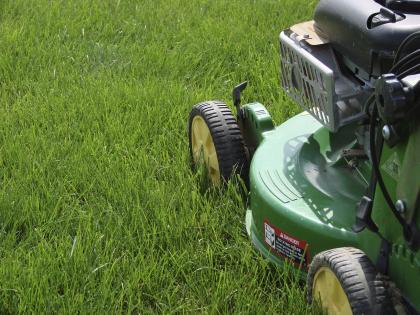November 25, 2014
How to maintain a healthy lawn in seven simple steps
More information on healthy lawns can be found online at:
Onatrio Ministry of Agriculture, Food and Rural Affairs
www.omafra.gov.on.ca
If your schedule gets in the way, consider either one-time services or a seasonal program from one of Landscape Ontario's lawn care members. Click here to find companies in your area.
Step 1: aerating and thatch control
- Aerate in the spring and fall before top dressing or fertilizing.
- Aerators can be rented or lawn care companies can provide the service.
- Alleviates compacted soil and allows water to penetrate deeper, producing deeper roots.
- Creates space in soil for penetration of air, water and nutrients.
- Physically breaks up thatch.
- A healthy lawn has 1 cm (1/2 inch) of thatch - more than 2.5 cm is too much.
- Unhealthy amounts of thatch prevent water and nutrients from reaching roots.
- Thatch can harbour insects and diseases.
- Use a de-thatching machine or hire a lawn care company.
- Grass grows best in a moist, fertile soil that is not waterlogged.
- Sandy soil and heavy clay both need humus to improve the texture.
- A deep dense root system is most important to support top growth in grass.
- A minimum of 4 in. (10 cm) of soil is needed.
- More soil = deeper roots.
- Soil samples can be sent for analysis. The results will include levels of phosphorus, potassium, pH and lime.
- pH levels are the measurement of acid and alkaline level. The optimum level is between 6.0 and 7.0. Test can be done by Agri-Food Laboratories, Imperial Rd. Guelph, 1-800-265-7175, www.agtest.com
- Top dress lawn with good quality top soil (1/4 to 1/2 inch), consisting of loam, peat moss and compost, to improve soil conditions.
- Can be combined with overseeding.
- Top-dressing and overseeding are ideal opportunities to introduce drought-resistant grass mixes.
- Best time is early fall, but can be done in spring if there is winter damage.
- Red fescue tolerates shade and drought conditions, requires low-fertility, rows well in the sun, has very fine leaves and spreads by runners.
- Perennial rye grass is drought tolerant, prefers full sun, but tolerates shade.
- Many perennial rye grasses contain levels of endophytic fungus, which help the roots take up water and nutrients. Hairy chinch bugs, bluegrass billbugs and sod webworms don't like the taste.
- Perennial rye grass retains its green colour very well during mid-summer heat stress.
- Mow high: 6 to 8 cm (approx 3 in.).
- Keep mower blades sharp.
- Mow frequently - cut no more than 1/3 of shoot length.
- Leave clippings on the lawn to provide a natural source of nitrogen.
- Very important to grass health.
- Provides nutrients to out grow weeds.
- Use a slow release type of fertilizer, and follow instructions.
- Use a spreader for even application.
- Consider using organic fertilizers.
- Apply a fertilizer specifically formulated for turfgrass. An established lawn with a good root system can seek out phosphorous already in the soil. The Lawn Care Sector Group of Landscape Ontario recommends using a phosphorus-free fertilizer on established turf.
- Nitrogen needs to be applied each year.
- Phosphorus and potassium are stable in soil.
- Late fall fertilization is best to increase fall and spring root growth and also results in an early spring green up.
- Promotes a thicker lawn.
- Timing is critical - in the fall, the turf has stopped growing above the soil, but the roots are still active.
- Follow-up with late May, early June fertilization (consider corn gluten meal and deal with crabgrass at the same time).
- Integrated Pest Management is as good as conventional pest management.
- Pull any broadleaf weeds by hand.
- Annual weeds: prevent flowering by mowing and/or hand pulling.
- Grass weeds: apply a pre-emergent (prevents germination) treatment. Try corn gluten meal Turf Maize.
- Perennial rye grass mix will minimize chinch bugs, bluegrass billbugs and sod webworms.
- Apply nematode spray for grubs.
- Let a healthy lawn go dormant during extended dry periods. It can survive four to six weeks without adequate water.
- Water only during an extreme drought or if lawn is under stress or renovation to begin with. If your lawn is dormant:
- Check regularly for insect pests
- Keep traffic off
- Stop mowing
- Do not fertilize
- Water deeply: 2.5 cm (one inch).
- Water infrequently: Less than once a week.
- Water before 10:00 a.m. to avoid evaporation and for best health.
- Follow any regional watering restrictions.
| April | Clean-up, rake, investigate winter damage |
| May | Aerate if needed Top-dress and overseed if needed Pull dandelions and other weeds Apply corn gluten meal Pre-emergent for crab grass Fertilizer Wait 30 days if overseeding |
| June | Pull dandelions and other weeds Monitor grubs |
| July | Monitor grubs Monitor chinch bugs |
| August | Apply nematodes if necessary for grubs Late in the month, overseed with drought resistant grass — perennial rye grass or red fescue |
| September | Overseed early in the month Monitor and pull weeds |
| October | Buy fertilizer |
| November | Apply late season fertilizer |
More information on healthy lawns can be found online at:
Onatrio Ministry of Agriculture, Food and Rural Affairs
www.omafra.gov.on.ca
Guelph Turfgrass Institute
www.uoguelph.ca/GTI
This document is a summary of a presentation made by the Kitchener Master Gardeners in spring 2008 as part of the Region of Waterloo's Naturescaping Seminars.
